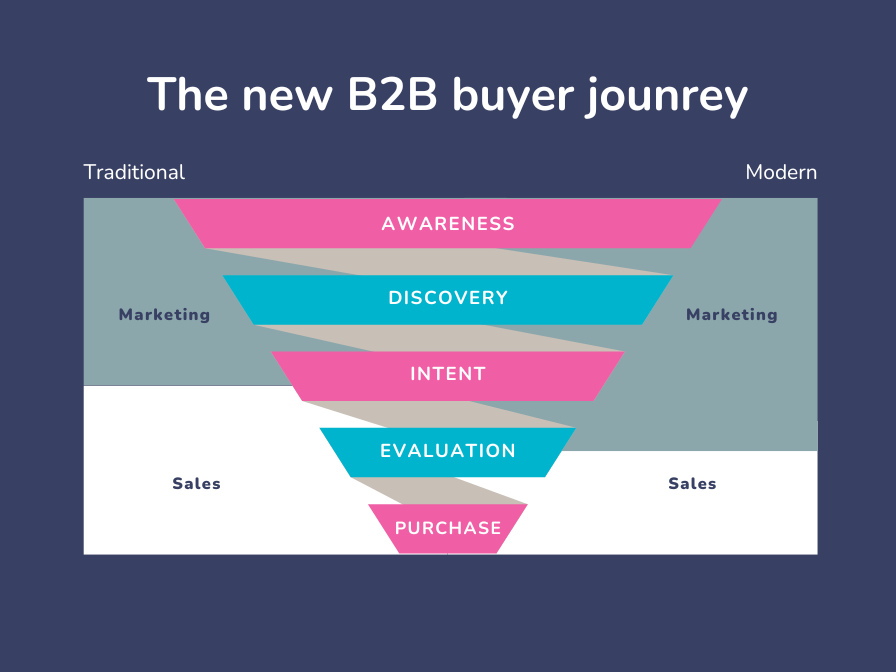The complete guide to sales and marketing alignment
In this blog
- What is sales and marketing alignment?
- Why is sales and marketing alignment important?
- Sales and marketing alignment statistics
- Challenges of sales and marketing alignment
- Benefits of sales and marketing alignment
- How to align sales and marketing: 14 tips
- 1. Jump on calls together
- 2. Assign ambassadors from each team
- 3. Meet up regularly
- 4. Brainstorm together
- 5. Socialise together
- 6. Stay close
- 7. Create a group chat
- 8. Make sure you get buy-in
- 9. Develop joint personas and profiles
- 10. Create content for all of the funnel
- 11. Lead scoring
- 12. Lead nurturing
- 13. Influencing the modern buyer
- 14. Seamless handoff between teams
- Alignment case studies

What sales and marketing alignment actually means, why it’s a challenge (but important), and how to do it properly.
Are your sales and marketing teams working in silos, missing out on crucial opportunities? Misalignment between these functions is a widespread issue. The lack of cohesion often leads to inefficiencies, lower quality leads, and ultimately, lost revenue.
The solution lies in aligning sales and marketing efforts, ensuring both teams work collaboratively towards shared goals. By fostering better communication, transparency, and teamwork, your business can enhance lead conversion rates and significantly boost profitability.
In this guide, we’ll cover 14 practical steps to achieve seamless sales and marketing alignment and unlock your company’s full potential.
What is sales and marketing alignment?
Sales and marketing alignment describes the goal of the two teams working with better collaboration, more transparency, better communication, and greater efficiency.
The end goal is to convert leads and achieve sales at an enhanced rate and profitability.
Historically, these two closely-related departments have developed independently of each other, using different systems, sitting separately in offices, and reporting with separate metrics.
Sales and marketing alignment to break down these barriers and allow sales and marketing to work collaboratively.
When marketing and sales teams drive towards the same goals, return on investment (ROI) dramatically improves, as does sales productivity, and ultimately, revenue.

Why is sales and marketing alignment important?
So, what’s the obsession with aligning sales and marketing? Well, it’s driven by the dawning of a new reality: the age of the customer.
The customer-centric approach has fundamentally changed how businesses communicate with their customers, even in the B2B world.
B2B customers are increasingly choosing to only engage with sales teams later in the sales funnel – being happy to carry out their own research through the interest phase and on into the consideration phase.
Buyers want to source their own information, and with social media and user reviews at their fingertips, they can find that with or without a brand’s input.
So if you want to continue the conversations with your prospects, you need to hold off on the sales pitch and use marketing to satisfy that quest for information.
This means that, more than ever, sales and marketing teams needed to be working together to nurture leads and ensure timely handovers from one team to another.
Sales and marketing alignment statistics
Although the above explains the historical need behind the drive for alignment, the below statistics show the current scale of the problem, and the potential size of the prize if done well.
- 90% of sales and marketing professionals say they are misaligned across strategy, process, content and culture.
- 60% agree that this misalignment between sales and marketing damages financial performance.
- 23% of salespeople cited better-quality leads as their top marketing team requirement, and 15% ranked more leads as their top priority.
- Only 7% of salespeople said the leads they received from marketing were very high quality.
- 59% of marketers claim to know what content sales teams want them to create, but only 35% of salespeople agree.
- 68% of marketers believe sales teams don’t use the content they do produce to its maximum potential.
- One-third of sales and marketing teams don’t hold regular meetings.
- 87% of sales and marketing leaders say collaboration between their departments enables business growth
Here’s how one analyst sums up the current state of play:
“There’s a genuine absence of a relationship between the two functions. And this is holding back critical business growth. Aligning sales and marketing strategically and tactically around joint purpose and success is the only way to drive growth and realise a return from investments in both people and programmes.”
Challenges of sales and marketing alignment
- Communication barriers: A lack of regular communication can contribute to misalignment caused by the two teams’ different goals and incentives.
- Misaligned objectives: Sales and marketing functions have different key performance indicators (KPIs).
- Data discrepancies: Varying metrics and data used by each team can cause confusion and mistrust.
- Cultural differences: Separate departmental cultures can create silos and reduce collaboration.
- Resource allocation: Uneven distribution of resources can lead to inefficiencies and frustration.
Benefits of sales and marketing alignment
- Increased revenue: Aligned sales and marketing departments can see higher conversion rates and shorter sales cycles.
- Improved customer retention: Working together allows for more aligned customer expectations, a deeper understanding of customer needs and better retention rates.
- Higher win rates: Coordinated efforts and effective lead nurturing help convert MQLs into SQLs and close more deals.
- Clearer customer journey mapping: Alignment offers a complete view of the buyer’s journey, ensuring better campaign execution and targeted strategies.
- Productive feedback loop: Open communication fosters trust and creates a feedback loop that enhances performance for both teams.
- Enhanced marketing performance: Alignment makes marketing accountable for revenue, leading to the generation of higher-quality leads.
- Avoiding blame: Shared goals and collaborative problem-solving reduce interdepartmental blame, fostering a harmonious working environment.
- Adaptability and growth: A unified strategy enables quicker adaptation to market changes, supporting business growth and innovation.
The benefits of aligning sales and marketing strategies can be seen in statistics concerning the bottom line. B2B companies that are aligned:
- Save 30% on their customer acquisition cost
- Enjoy a 36% higher customer retention rate
- Customers have a 20% higher lifetime value
- Get a 38% higher sales win rate than non-aligned teams
- Achieve 39% higher annual revenue growth than non-aligned teams
- See 27% faster profit growth
How to align sales and marketing: 14 tips
So how can you start to create a “smarketing” department, bridge the gap and align your sales and marketing teams?
There are some highly practical steps to begin the process, and they don’t have to involve any large-scale organisational change. Here are some quick changes you can make right now to get your sales and marketing teams better aligned.
1. Jump on calls together
A simple way for marketing to begin better communication is to sit in on sales calls. Better still, you could take this one step further by inviting marketing team members to attend sales pitches.
Both are great ways to hear first-hand the key barriers and concerns of potential customers or even test out new messaging before it goes live.
2. Assign ambassadors from each team
How about nominating one person from sales and one from marketing to act as the bridge between the teams?
Their role would be to ‘sit between’ the teams, chase up on requests, initiate reviews and facilitate coordination and cooperation.
3. Meet up regularly
Whether it’s monthly or weekly, it is critical that there is a regular slot in everyone’s diary when the two teams can meet.
At these meetings:
- Sales can report honestly on challenges or successes, conversations they are having around competitors, and so on.
- Marketing can feedback on campaigns and strategies that are live or in the pipeline.
4. Brainstorm together
Make sure these meetings don’t become stale reporting exercises. Allow space to creatively solve challenges together and brainstorm topics.
Here are some ideas for starters:
- Use intel gained by the sales teams about what’s exciting and frustrating prospects. This is live market research and is incredibly valuable to marketers.
- You can look into funnel metrics such as lead generation, MQLs, and lead-to-customer conversion rate? Identify where the blockages are and pinpoint what may be causing them.
- Review and classify your accounts and customers with a view to setting responsibility within both sales and marketing for working these accounts. This is the basis for ‘account-based marketing’ (ABM), helping to ensure marketing collateral is targeted to customers and used by sales.
5. Socialise together
Whether it’s an event, conference or just a swift drink after work, the more time teams spend together in a casual setting the better the bonds are in the office.
A major part of aligning is simply allowing for easy conversations and information sharing across the teams. Our sales and marketing teams recently went go-karting as a bonding trip, and one particularly talented content specialist surprised everyone by finishing third.
6. Stay close
You don’t necessarily need to shake things up drastically and create a unified department under one ‘head’. Simply shifting a few office chairs so that sales and marketing sit together can help to foster unity.
When we did this recently, one thing that’s instantly noticeable is the amount of useful conversations that arise when one team has overheard the other talking about an idea or issue.
7. Create a group chat
Another way to ensure information is shared among the two teams is to simply create a channel or chat on whatever messaging system you use.
This should be used to share important information, but can also be used more generally to chat, share ideas, and follow up on project progress.

8. Make sure you get buy-in
“60% of content created in the marketing department was never used.
And 90% of the content we were creating was product-specific, despite the fact that most of our audience were in an early-stage part of the buyer stage and asking non-product specific questions.”
Michael Brenner, Head of Strategy at Newscred, speaking about his experience at SAP.
I’d like to guess that many organisations can relate to this. In fact, research by Sirius Decisions found that 60-70% of all B2B marketing content is unused by sales.
The first issue to solve is to ensure that the content we create is timely and driven by prospect needs. The second is to ensure that the sales team is aware of and buys in to the content created.
To do this you dedicate a section in your regular meeting, use a shared content calendar, post it in your Slack channel, or organise a way for sales to request content that aligns with their needs.
9. Develop joint personas and profiles
Developing buyer personas and customer profiles that both teams can use is crucial for aligning the goals and metrics shared between sales and marketing.
By creating a shared persona, teams can develop a deeper understanding of pain points, needs, preferences and behaviours – and collateral based on that information.
10. Create content for all of the funnel
Lead generation is a great place to start. But the average buyer is nearly two-thirds of their way through the buying cycle before speaking to a salesperson, so content needs to go beyond this.
Marketing needs to create content that targets prospects at all stages of the funnel. Relevant content can help move prospects further down the funnel until they are ready for sales.
It’s vital that content creation is distributed throughout the funnel – and this includes after the handover to sales, and even beyond closing the deal – marketing should continue once they are customers.
11. Lead scoring
Marketing plays a crucial role in qualifying sales leads through lead scoring. Lead scoring assigns a value to your leads based on different factors such as their behaviour, demographics, and firmographics.
These scores help sales and marketing teams evaluate a lead’s likelihood of converting into a paying customer. By focusing on high-quality leads, sales can prioritise their efforts on prospects with the highest potential, while marketing can disqualify others from further nurturing.
12. Lead nurturing
Lead nurturing is another area ripe for collaboration. Some leads will be in marketing’s orbit, interested in reading newsletters and attending webinars. If they become qualified and handed over to sales, they will be more interested in bottom of the funnel content, like case studies.
The sales team should be able to easily request specific content aimed at different personas, industries, or problems.
13. Influencing the modern buyer
In today’s digital age, marketing influences buyers who are more informed and self-reliant. Through targeted content and strategic outreach, marketing educates and engages prospects long before they interact with sales.
With more buyers and complex decision-making processes, multiple touchpoints are required to keep prospects engaged and informed.
It’s therefore vital that sales and marketing are aligned on messaging so prospects don’t suddenly get a different message once they speak to a sales rep.
14. Seamless handoff between teams
A smooth transition of leads from marketing to sales is critical. Clear protocols and continuous communication ensure that the handoff is seamless, maintaining the prospect’s engagement and interest.
By integrating these additional strategies into your alignment efforts, you can create a more cohesive and effective sales and marketing partnership. This will enhance team performance and significantly boost your business’s overall success.
Alignment case studies
Finally, there are companies that have successfully aligned their departments, and reading these case studies can be a good way to consider improvements we can make.
- O2 recently restructured its sales and marketing processes and went on to smash its targets by 325%.
- BabelQuest found alignment significantly increased inbound inquiries from prospects who offered a perfect fit for their services. They went from three out of four poor quality inbound leads to two out of three inbound inquiries becoming SQLs or being placed into a nurture sequence.
If you’re looking to boost your internal teams, Sopro’s demand generation service seamlessly supports your existing sales strategy by plugging in a reliable flow of leads and improving sales efficiencies, whether you need a lead generation agency for small businesses or a lead generation agency for international businesses.




Share